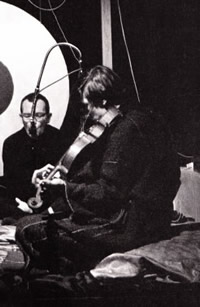

New York 1965-12-06
The Tortoise, His Dreams and Journeys with the Theatre of Eternal Music led by La Monte Young at the Cinematheque in New York - December 6, 1965. This is Cale's final performance with the group.
They performed The Ballad of The Tortoise or Pierced Earrings/Drone Ratios Transmitting The Manifestation of The Tortoise Center Drifting Obsidian Time Mists through The Synaptic Stepdown Barrier.
This performance incorporated Marian Zazeela's "Ornamental Lightyears Tracery" lighting effects projections. When Andy Warhol saw Zazeela's light projections he would turn this into the Exploding Plastic Inevitable shows.
La Monte Young: voice
Marian Zazeela: voice, light projections
Tony Conrad: violin
John Cale: 3-string drone
David Hayes: projections
From the notes of La Monte Young:
The specific rules that governed the performance of my music, including the sections of The Tortoise, His Dreams and Journeys participated in by Tony Conrad and John Cale, create a sound characterized by the predominance of musical intervals whose numerators and denominators in just intonation are factorable by the primes 7, 3, and 2, and selected higher primes, especially 31, and by the exclusion of intervals whose numerators and denominators are factorable by the prime 5. If we represent intervals with numerators and denominators factorable by the primes 7, 3, and 2 in conventional music notation and terminology, we obtain intervals that include various sized major and minor sevenths (with emphasis on the septimally derived blues minor seventh in my compositions such as Bb Dorian Blues, Early Tuesday Morning Blues, Sunday Morning Blues, and The Tortoise), perfect fifths, octaves, unisons and their inversions, various sized major and minor seconds, and perfect fourths. The blues I was playing on the sopranino saxophone, directly preceding the period of The Tortoise, emphasized a technique I invented consisting of extremely fast combinationpermutations of a limited set of tones to simulate a sustained chord. And the chord I increasingly emphasized consisted of the pitches Eb, Bb, Db, Eb, (the IV-chord from Bb Dorian Blues) extended over the full range of the saxophone. Translated back into just intonation, these pitches are all examples of octave transpositions of the primes 7, 3, and 2.